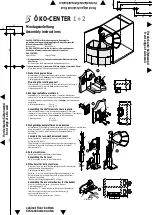
English
- Eng-7 -
Installation and General Instructions
(continued)
11. DO NOT use this oven to heat chemicals or other
non-food products. DO NOT clean this oven with
any product that is labeled as containing corrosive
chemicals. The heating of corrosive chemicals in
this oven may cause microwave radiation leaks.
12. If
glass tray
is hot, allow to cool before cleaning or
placing in water.
13. When using the COMBINATION mode, never
place any aluminum or metal container directly
on the wire rack. Always insert a heat-proof,
grass plate or dish between the wire rack and the
aluminum container. This will prevent sparking
that may damage the oven.
14. During cooking, some steam will condense inside
and/or on the oven door. This is normal and safe.
Steam will disappear after the oven is cool down.
15. Metallic containers for food and beverages are
not allowed during microwave cooking.
16. It is recommended not to use the wire rack when
cooking in the MICROWAVE mode only.
17. Only use utensils that are suitable for use in
microwave ovens.
Placement of Oven
This oven is intended for Counter-top use only. It is
not intended for built-in use or use inside a cupboard.
1.
The oven must be placed on a flat, stable surface.
It shall not be placed in a cabinet. For correct
operation, the oven must have sufficient air flow.
Allow 15 cm of space on the top of the oven,
10 cm at back and 5 cm on both sides. If one side
of the oven is placed flush to a wall, the other side
or top must not be blocked. Do not remove feet.
15 cm
5 cm
10 cm
Counter-top
Open
(a) Do not block air vents. If they are blocked
during operation, the oven may overheat. If
the oven overheats, a thermal safety device
will turn the oven off. The oven will remain
inoperable until it has cooled.
(b) Do not place oven near a hot or damp surface
such as a gas stove, electric range or sink etc.
(c) Do not operate oven when room humidity is
too high.
2.
This oven was manufactured for household use only.
Food
1.
Do not use your oven for home canning or the
heating of any closed jar. Pressure will build
up and the jar may explode. In addition, the
microwave oven cannot maintain the food at the
correct canning temperature. Improperly canned
food may spoil and be dangerous to consume.
2.
Do not attempt to deep fat fry in your microwave
oven.
3.
Eggs in their shell and whole hard-boiled eggs
should not be heated in microwave ovens since
they may explode, even after microwave heating
has ended.
4.
Potatoes, apples, egg yolks, whole squash and
sausages are examples of foods with nonporous
skins. This type of food must be pierced before
cooking, to prevent bursting.
5.
When heating liquids, e.g. soup. sauces and
beverages in your microwave oven, overheating
the liquid beyond boiling point can occur without
evidence of bubbling. This could result in a
sudden boil over the hot liquid. To prevent this
possibility the following steps should be taken.
(a) Avoid using straight-sided containers with
narrow necks.
(b) Do not overheat.
(c) Stir the liquid before placing the container in the
oven and again halfway through cooking time.
(d) After heating, allow to stand in the oven for
a short time, stirring again before carefully
removing the container.
(e) Microwave heating of beverages can result in
delayed eruptive boiling, therefore care must
be taken when handling the container.
(f) As a general rule, always cover wet foods,
e.g. soups, casseroles and plated meals.
6.
DO NOT USE A CONVENTIONAL MEAT
THERMOMETER IN THE MICROWAVE OVEN.
To check the degree of cooking of roasts and
poultry use a MICROWAVE THERMOMETER.
Alternatively, a conventional meat thermometer
may be used after the food is removed from the
oven. If undercooked, return meat or poultry to
the oven and cook for a few more minutes at the
recommended power level. It is important to ensure
that meat and poultry are thoroughly cooked.
7.
COOKING TIMES given in the cookbook are
APPROXIMATE.
Factors that may affect cooking
time are preferred degree of moisture content,
starting temperature, altitude, volume, size, shape of
food and utensils used. As you become familiar with
the oven, you will be able to adjust for these factors.
8.
It is better to
UNDERCOOK RATHER THAN
OVERCOOK
foods. If food is undercooked, it
can always be returned to the oven for further
cooking. If food is overcooked, nothing can be
done. Always start with minimum cooking times
recommended.
9.
Extreme care should be taken when cooking
popcorn in a microwave oven. Cook for minimum
time as recommended by manufacturer. Use
the directions suitable for the wattage of your
microwave oven. NEVER leave oven unattended
when popping popcorn.
10. When heating food in plastic or paper containers,
keep an eye on the oven due to the possibility of
ignition.
11. The contents of feeding bottles and baby food jars
shall be stirred or shaken and the temperature
checked before consumption, in order to avoid
burns.
F0003CD50KP-O-I_part-0719.indd 7
2019/7/19 13:30:12








































